
Water Sports in Puerto Rico
The Best Spots for Watersports
Between kayaking, snorkeling, scuba diving, and stand-up paddleboarding, this Island has it all.
Puerto Rico’s beaches are ready to welcome you at any time of the year, thanks to the Island’s warm tropical climate. Beaches there are never off-limits, and each one has something unique to offer, depending on the type of experience you want to have during your visit.
From picture-perfect views to sailing adventures, Puerto Rico’s stunning beaches include sandy stretches perfect for lounging in the shade, catching a wave, paddling a kayak, or exploring underwater on a scuba diving or snorkeling adventure.
Whether you’re looking to catch some waves and surf all day near the west coast towns of Rincón and Aguadilla or do some serious scuba diving in Isla de Mona or Culebrita, water sports in Puerto Rico are a fun experience. Boat your way through the passages of La Parguera or the incredible blue sights of Punta Arenas in Vieques and be enchanted by Puerto Rico’s Caribbean waters. If you’re planning to stay in San Juan, you can always stand-up paddle in the Condado Lagoon for amazing views of the city.
Best Spots for Snorkeling and Diving
In Puerto Rico, feeling blue takes a whole new meaning. With protected marine areas and pristine islets and cays with vibrant ocean life, several spots make snorkeling a dream-like activity during vacation. And isn’t snorkeling the ultimate tropical vacation activity? From swimming with sea turtles – and sometimes even dolphins – to admiring different reefs and playful tropical fish, the waters surrounding Puerto Rico offer unique encounters in the ocean.
Snorkeling tours in Puerto Rico are safe, so whether you are a first-timer or an experienced swimmer, you can enjoy your day underwater down on the island.
The Mona Passage
The west region of Puerto Rico is also full of colorful marine life. Off the coast of Rincón are Desecheo, Mona, and Monito, three uninhabited islands popular for snorkeling and diving. These three spots make up the famous Mona Passage known as the Galápagos of the Caribbean. These cays have crystal-clear waters that make it easy for swimmers to find their way around the colorful rocks and boulders surrounding the corals.
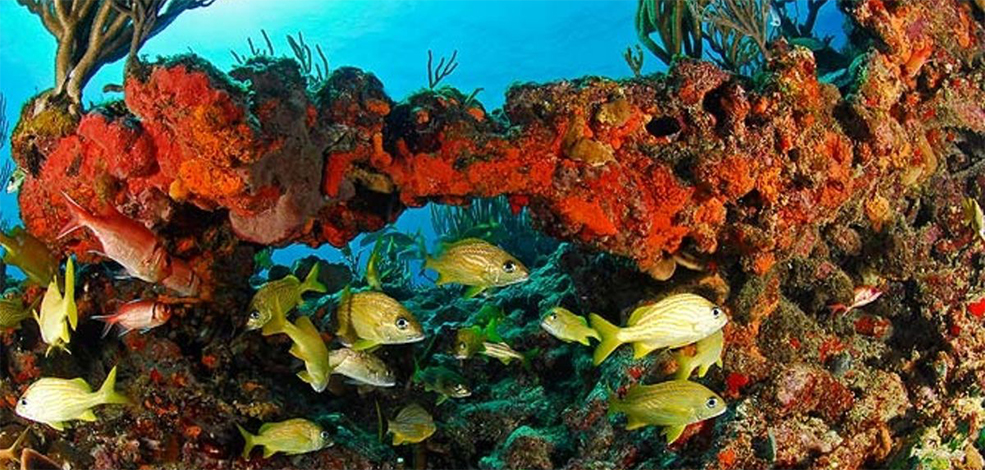
Mona Island
You’ll find vibrant sea fans and big schools of diverse fish, shrimp, and starfishes, turtles, and sometimes dolphins that will brighten your dive. You’ll see undersea canyons and caverns you can dive into or observe from above. These protected reserves can only be reached by boat, so make sure to book a trip in advance.
Culebra Beaches
Arguably the best snorkeling spot in Puerto Rico is Culebra. The offshore island is located approximately 17 miles from the mainland and boasts an impressive coral underwater wildlife.
Some of the best snorkeling in Culebra can be found right off several of the amazing beaches in Culebra. The best spots are Carlos Rosario, Tamarindo Beach, Melones Beach, Punta Soldado, and Flamenco Beach, along with off shore spots like Culebrita.
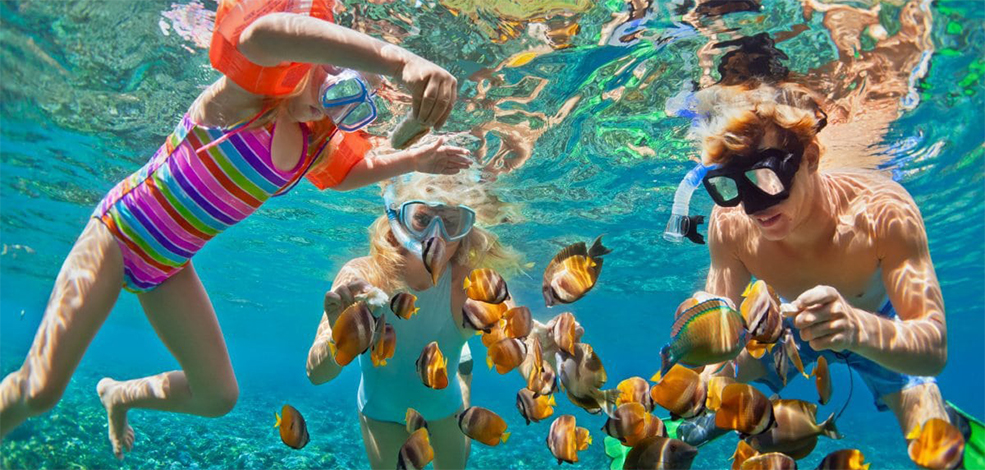
Diving in Culebra Beaches
The best snorkeling is to the far right on Flamenco Beach, where the sand ends and the rocks begin (that would be the east end of the beach). This area is called "Shark Cages" (or "Muellecito", by the locals).
In addition to the best beaches for snorkeling in Puerto Rico, there are several offshore spots to explore with a boat tour. Keep in mind that Culebra is another island, and so you’ll need to get there via plane or by boat.
Escambrón Beach - San Juan
A popular snorkeling destination in San Juan is Escambrón Beach, right next to the Caribe Hilton Hotel. This beach has several rock formations that protect it from the rough surf of the Atlantic Ocean. Also, since the beach is frequented by snorkelers and scuba divers the fish that live around the shore are used to people and you can come right up close.
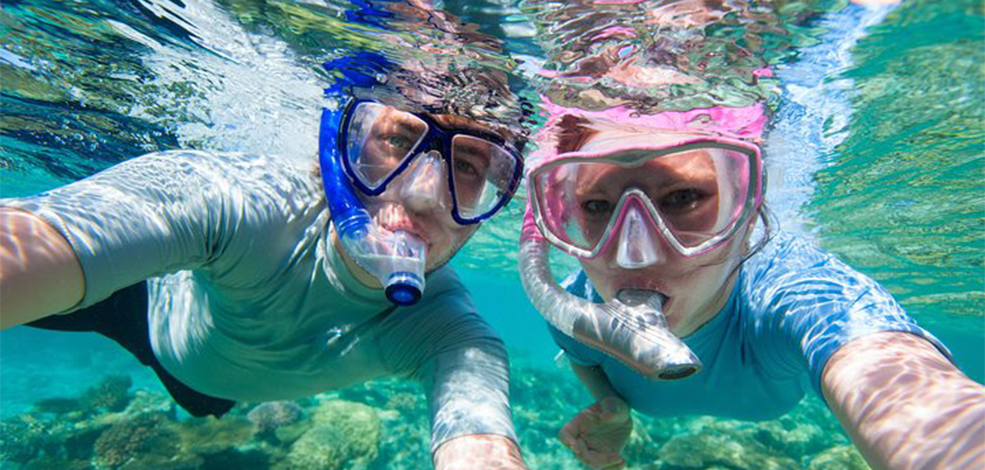
Diving in Escambron Beach
The publicly maintained beach in the San Juan neighborhood of Puerta de Tierra features a small crescent beach on a protected cove. On the ocean floor is a collapsed bridge that provides an excellent site for underwater exploration.
Next to the main beach is Escambron Marine park with underwater statues and structures. Manatees are even known to be seen here. Although you won’t find the variety of coral and fish that you may see in places like Culebra and Vieques, a stop at Escambron beach is a great break from the city with the best snorkeling in the area.
Rincon Snorkeling and Diving
Rincon is famous for its surfing in the winter, but in the summer those coral reefs that cause the large swells are perfect to explore. Steps beach is probably the most popular snorkeling beach in Rincon. Located within the Tres Palmas Marine Reserve, Steps Beach has a huge amount of elkhorn coral to explore. Because it’s located within a marine reserve, you won’t have to worry about boats either.
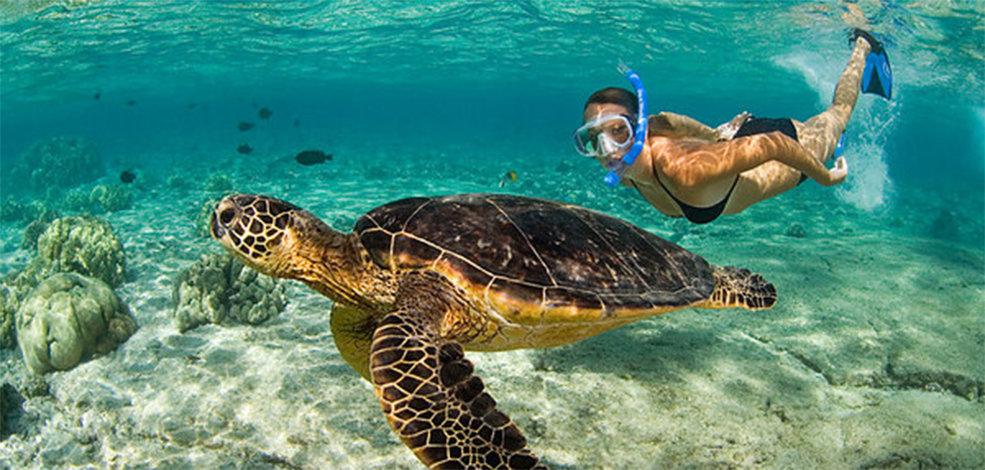
Rincon Snorkeling and Diving
Rincon is also the jumping off point for exploring Mona Island and Desecheo Island, both uninhabited and home to fantastic reefs. If you’re wanting to explore either of these islands, a boat tour will be required as they are far off shore.
La Parguera Nature Reserve
La Parguera Nature Reserve is located on the southwest coast of Puerto Rico. The beautiful area is made up of a collection of coral reefs, mangrove islands, and small cays. Living in these waters is a rich collection of sea life such as dolphins, barracudas, and turtles. One of the three bioluminescent bays in Puerto Rico is located here as well, so make sure to add that to the list!
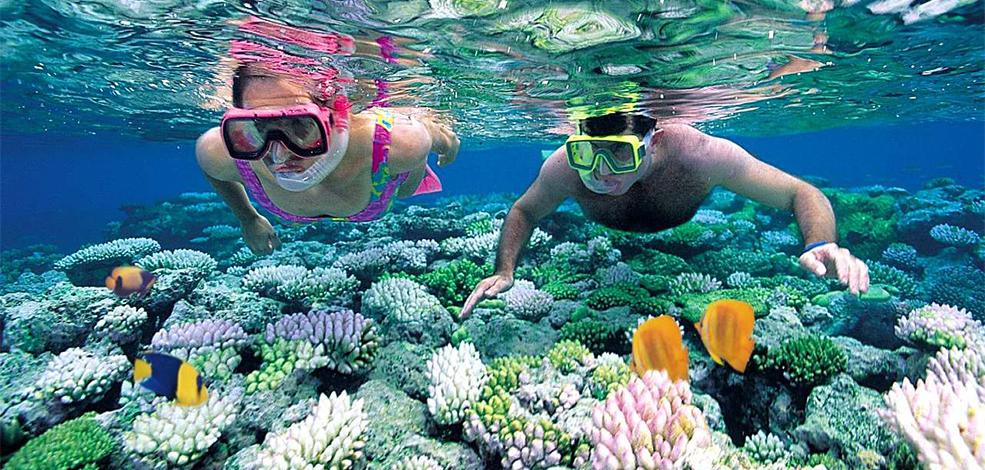
La Parguera Nature Reserve
Although there are many places to enjoy a solo snorkeling mission in Puerto Rico, La Parguera is one of the areas that is best explored with a tour. Most of the best places to snorkel in the Marine Reserve are off the coast and only reachable by boat or kayak.
Tamarindo Beach and Carlos Rosario Beach
With rolling mountains as a backdrop and gin clear waters beckoning you in, the beaches of Tamarindo and Carlos Rosario lure scuba divers and snorkelers to the small island off Culebra, off Puerto Rico’s east coast. Both beaches are located on Culebra’s northwest coast; you can drive to Tamarindo, but you’ll need to hike in from Flamenco Beach to Carlos Rosario.
The mangrove-fringed waters and coral reefs protected within the Luis Peña Natural Reserve here shelter a kaleidoscope of marine life. And on underwater excursions you might spot sea turtles and huge groupers or find yourself finning within clouds of colorful reef fish.
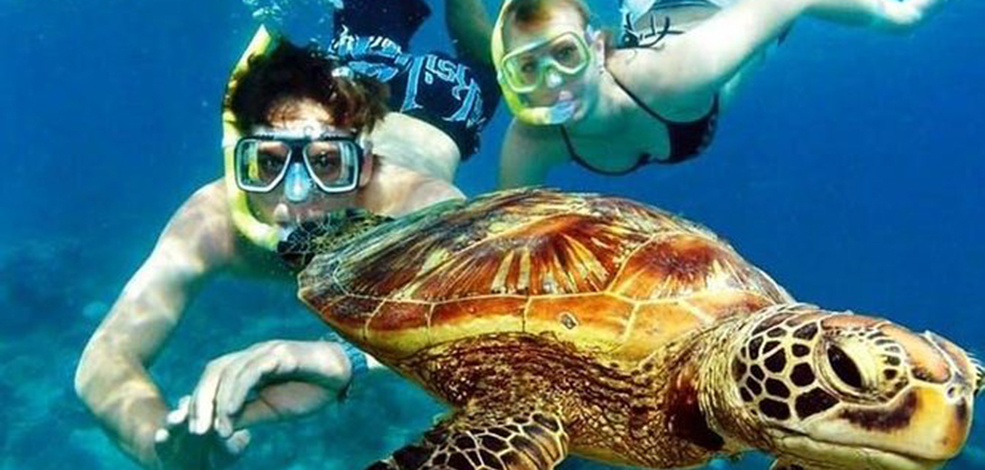
Diving in Tamarindo Beach and Carlos Rosario Beach
You can snorkel right from the beach at Tamarindo, but certified divers make a point to head out with operators that visit some of the more than 50 dive sites around the island. It’s also best to join a guided snorkeling tour to visit Carlos Rosario Beach, in the island’s northwest corner, which can only be accessed via boat or a steep hike in from Flamenco Beach. Culebra, which is just seven miles long and two miles wide, has a good selection of small hotels, inns, and cottages where you can stay a night or longer.
For easy access to a site rich in marine life, visit Playa Carlos Rosario, a narrow beach flanked by boulders and a protruding coral reef in Culebra. The underwater visibility is usually quite good here, and the coral reef, where you can see all kinds of colorful fish and coral formations, is teeming with marine life.
Tres Palmas Marine Reserve
Facing the turbulent Atlantic, the northwest coast is a mecca for surfers lured to epic (up to 30 ft.) waves during the winter. Calmer, crystalline waters during the summer transform the region’s beaches into a snorkeling playground. One of Puerto Rico’s crown jewels, Tres Palmas Marine Reserve preserves all seven endangered coral species, as well as schools of angelfish, moray eel, striped grunt, spiny lobster, sea turtle, leatherback turtle, whale and dolphin.
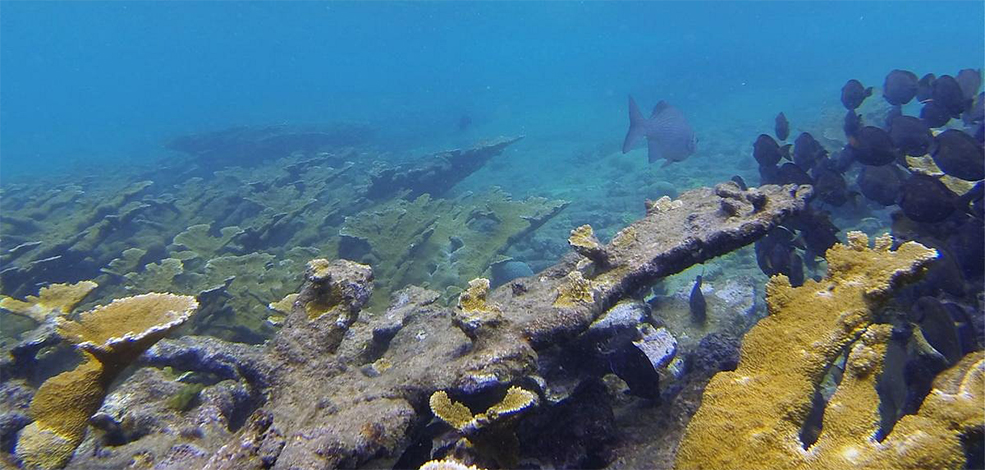
Tres Palmas Reserve
Tres Palmas comprises three beaches: Step’s Beach, Dogman’s Beach and Little Malibu Beach. At Step’s Beach, thickets of the world’s healthiest formations of rare elkhorn coral provide a rich food source for myriad fish and invertebrates.
Gilligan’s Island
Shallow, gin-clear waters, healthy coral, few visitors (during the week) and magical underwater life, Gilligan’s is one of the top family-friendly snorkeling destinations in the Caribbean. With a slow-moving current and kaleidoscopic schools of tropical fish, it’s a wonderful initiation into snorkeling.
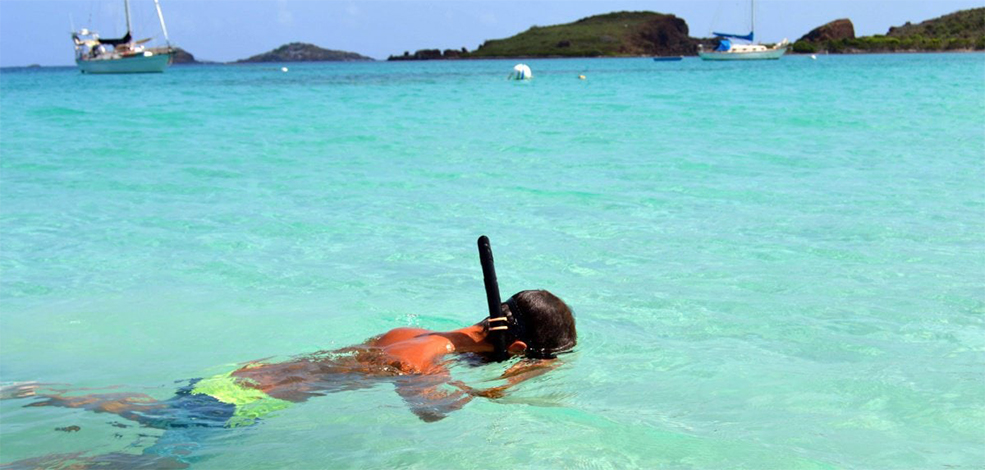
Diving in Gilligan’s Island
Families can rent kayaks from the marina and explore the two neighboring islets that make up Cayos de Caña Gorda, or cruise along serene mangrove channels. With no riptides, you can comfortably swim the perimeter of the island. To reach Gilligan’s, it’s a 10-minute ferry ride from Guánica, or you can kayak over from the mainland in around 30 minutes.
Vieques
The island’s biodiversity, clear waters, and Navy history make Vieques a fascinating snorkeling destination. Located off the east coast of the main island, this small island is home to the Vieques National Wildlife Refuge, protecting the wildlife that thrives here. Protected by the Vieques Wildlife Refuge, Vieques’s crystalline waters deliver some of Puerto Rico’s most enthralling and family-friendly snorkeling experiences. Vieques is known for its sightings of green sea turtles and spotted eagle rays. The island was occupied by the U.S. Navy for decades, and during that time it was virtually deserted, protecting the coral reefs from human damage.

Diving in Vieques
Today, Vieques offers unforgettable snorkeling experiences, with abundant marine life including green sea turtles, hawksbill turtles, spotted eagle rays, and nurse sharks. You can also encounter artifacts left behind by the Navy, making for unique underwater photos. Here are some of the top snorkeling beaches on the island:
La Chiva (Blue Beach): Clear waters and seagrass beds full of fish
Punta Arenas: Remote feel and stunning views
Mosquito Pier: For experienced swimmers and divers
On the north coast, the former military pier of Rompeolas-Mosquito is another storied site. The pier was built in 1941 to connect Vieques with the mainland of Puerto Rico; the plan was abruptly abandoned in 1943. Today, coral-covered beams and pillars provide a haven for marine life, such as turtles, starfish, sea urchins and vibrant tropical fish.
Coffin Island – Isla Caja de Muertos
For those staying near Ponce, the stunning Coffin Island is not a thing for snorkeling enthusiasts to miss. It lies eight miles (13 km) from the coast. Thanks to the 1700s French author who observed that the shape of the island looked like a cadaver within a coffin the name has stuck. An enduring legend of it being a haunt of pirates persists.
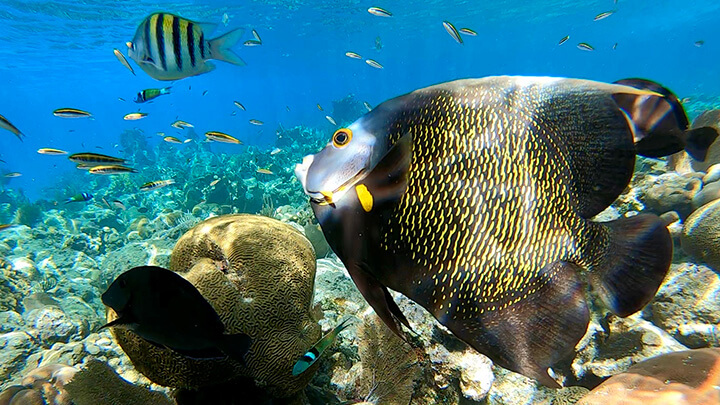
Dining in Coffin Island
To get out here you need to book with one of a few different day trip outfits or take the ferry from La Guancha Boardwalk. The natural reserve island includes hiking trails, incredibly beautiful beaches, a cave, and a light house. Local Pelican Beach earns the distinction of being a Blue Flag Beach.
For coral reef snorkeling it is best to go with the day trip expedition that will take you to the island’s northeastern side which is known as a good spot to swim with turtles in Puerto Rico since Coffin Island is home to a protected sea turtle population. Tour operators provide equipment but make sure you bring your own snorkel set since usually they do not have the best quality equipment.
La Cordillera Nature Reserve
It doesn’t get more pristine than La Cordillera in Fajardo. The group of nine small cays, including Icacos, Cayo Lobos, Palomino, Cayo Ratones, and others, is known for covering nearly 20 nautical miles. You can arrive by a water taxi, catamaran trip, or private charter to most of the cays and spend the day exploring its active seagrass bed.
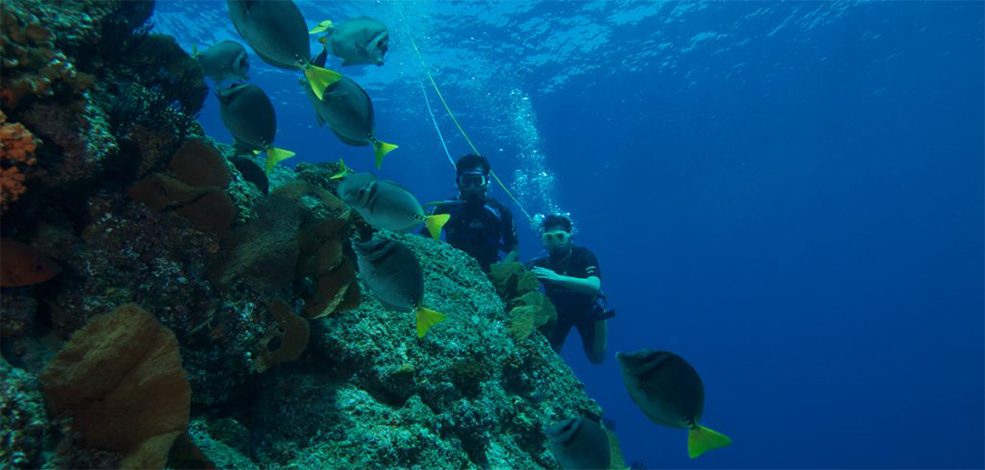
La Cordillera Nature Reserve
In this vibrant ecosystem, you’ll see turtles, manatees, sea cucumbers, starfishes, juvenile fish, queen conchs, and even stingrays. You’ll also notice the variety of reefs, spanning from rocky to fiery and the endangered elkhorn reef.
Best Spots for Kayaking and Paddle Boarding
Puerto Rico is a beach-lovers playground. The year-round "summer-like" conditions, crystal clear waters, and varied marine life make it the ideal setting for a day (or night) of paddling and Kayaking around in the ocean.
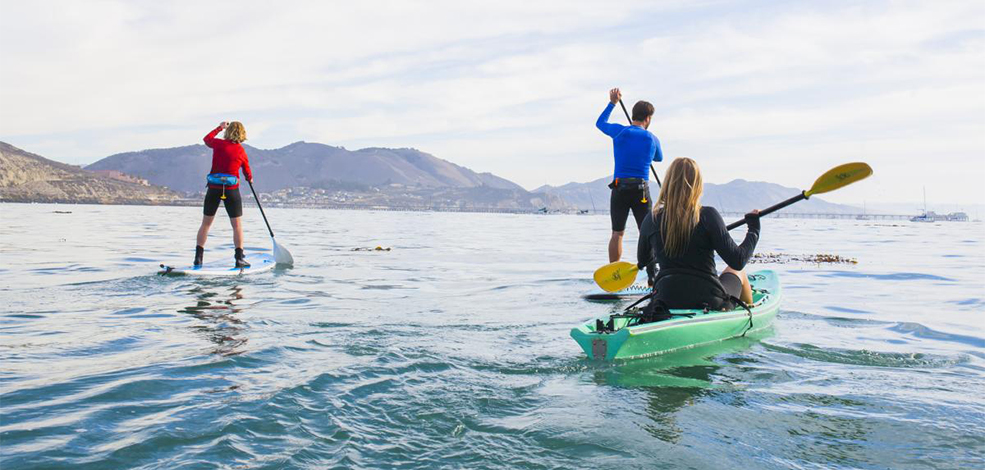
Kayaking and Paddle Boarding in Puerto Rico
With a seemingly endless selection of pristine beaches, guided trips, and plenty of equipment rentals all over the Island, you can have unforgettable experiences out in the water. Pick your preferred vessel and practice some paddleboarding or kayaking. The "class zero" slow currents in various spots around the Island make these activities manageable for beginners and younger family members.
In the city
The capital city's kayaking and paddle boarding opportunities are mostly concentrated in the Condado and Isla Verde neighborhoods. One popular spot for these splashy activities is the Laguna del Condado (the lagoon), where you can enjoy the peaceful environment. You have a good chance of spotting fish, turtles and even manatees in the waters below. Kayak and SUP rentals are available.
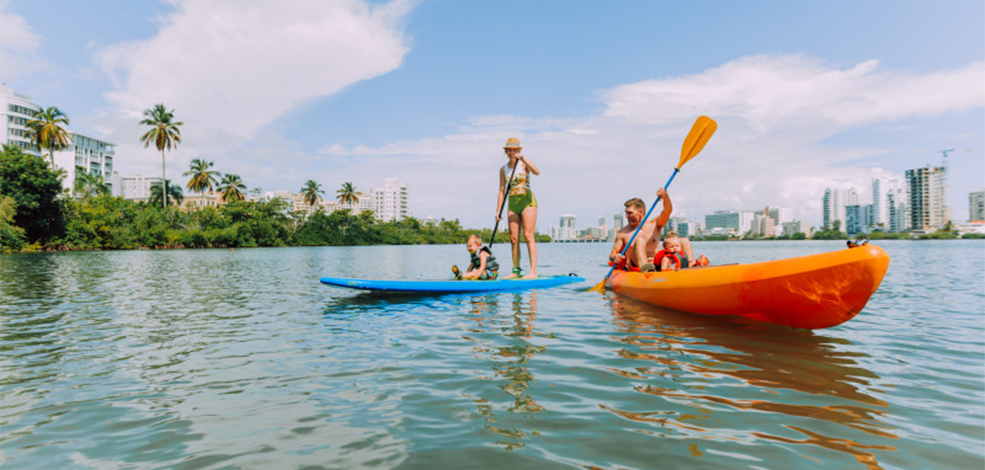
Laguna del Condado
Work on your tan lines and paddle under sunny skies during the day or paint your face with neon colors and paddle guided by the stars on a night excursion. At this well-maintained bayou, you can spot fishes, turtles, and even manatees that roam the lagoon while you venture in a glass-bottom raft.
If the lagoon feels a bit too touristy, head 20 minutes east to the laidback Piñones Beach instead. Here, you’ll find the Torrecilla Lagoon, which has mangrove forests and islands to explore. At Isla Verde, the seaside backdrop of the hotel strip (near the Fairmont El San Juan Hotel) is another ideal place to sharpen your skills. You will find many kayak and paddleboard rentals suited for the peaceful swells.
Bioluminescent Bays
Be ready to embark on a surreal experience at the bioluminescent bays Mosquito Bay, La Parguera, and Laguna Grande. Located in Vieques, Lajas, and Fajardo respectively, these magical marine habitats are best enjoyed at night, preferably during a new moon. Navigate across the mangroves and, as you paddle, notice the glow-in-the-dark effect that happens in the water when millions of microorganisms are agitated. It is an experience like no other!
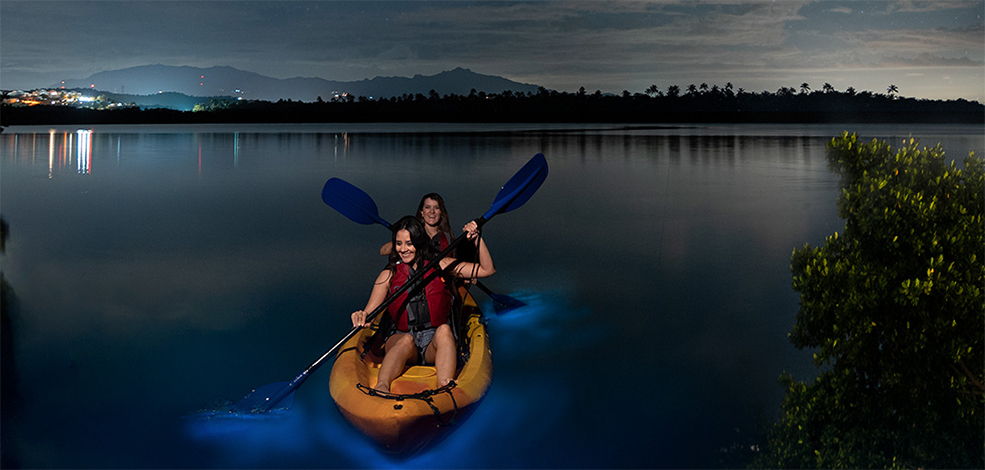
Bioluminescent Bays
Bioluminescence is one of planet Earth’s best-kept secrets. Tiny organisms make the water glow at night. They found the perfect place to live in the Fajardo Bio Bay. Stir the water of the Bioluminescent Bay and lots of sparkles will activate. Glowing trails will swirl and flow with the water.
Keep in mind that the roundtrips into the bio bays span for several miles, and swimming is not permitted to protect these unique ecosystems. You can paddleboard and practice other watersports in nearby beaches like Sun Bay and Mosquito Bay beach in Vieques, and Seven Seas in Fajardo.
Luis Peña Reserve
Culebra is all about reaching secluded reefs, cays, and islets in the Luis Peña Reserve, the place with the highest coral cover on the island. You will paddle through crystal-clear waters with imposing mountains in the background and colorful schools of tropical fish underneath.
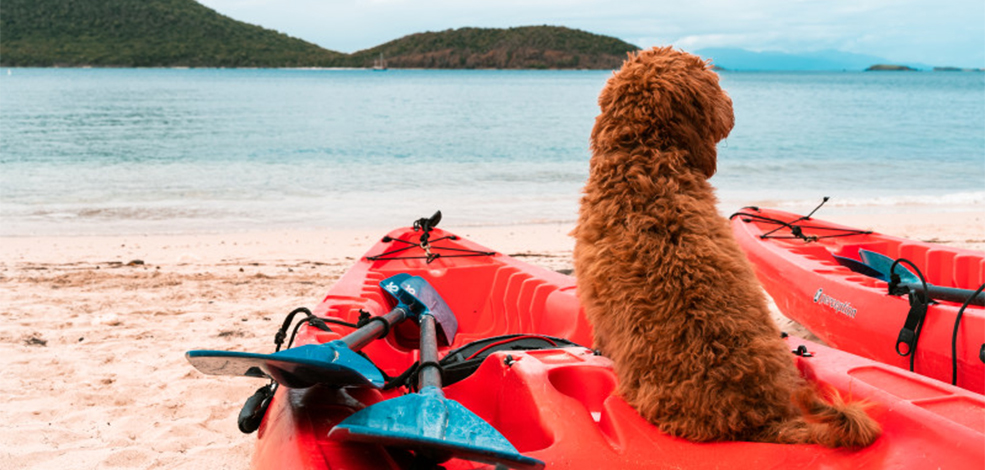
Reserva Natural Canal de Luis Peña
Pristine beaches like Tamarindo, Playa Melones, and Carlos Rosario – not to mention Flamenco – have stunning panoramic views to relish in and impeccably soft waves for those inexperienced paddlers. If you happen to bring snorkeling gear with you, be sure to step off your vessel for a swim to make the most of a day under the sun.
Isla Ratones “Ratones Cay”
Just off the coast of Cabo Rojo is the secluded, family-friendly reserve Isla Ratones. You can only get there by boat (and should bring all the supplies you need), but it is a trip worth taking. Be astounded by the white-sand beach and clear waters with soft waves that will make your activities a pleasure. Although the marine life is not as active as some other locations near Cabo Rojo, there are some mangroves and coral reefs around, so you'll surely see small fishes swimming around your boat.
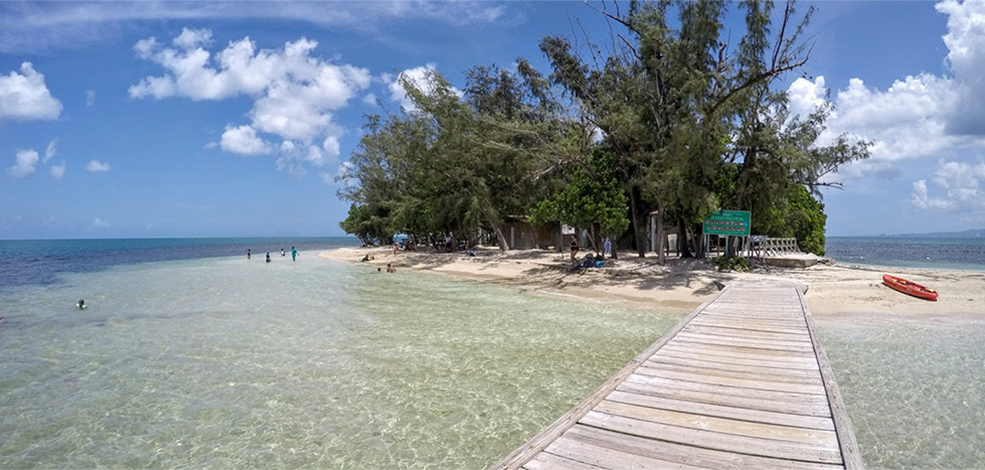
Isla de Ratones “Ratones Cay”
Isla Ratones is ideal for a full-day getaway, and there are roofed picnic stations with BBQ pits, restrooms, and showers. Adventures Tourmarine has a boat that goes back and forth to this little islet and rents out kayaking equipment for the day.
Culebra
Culebra is a small island off the east coast of Puerto Rico. It’s famous for beaches like the well-known Flamenco, amazing snorkeling spots, and great kayaking and paddleboarding for all abilities.
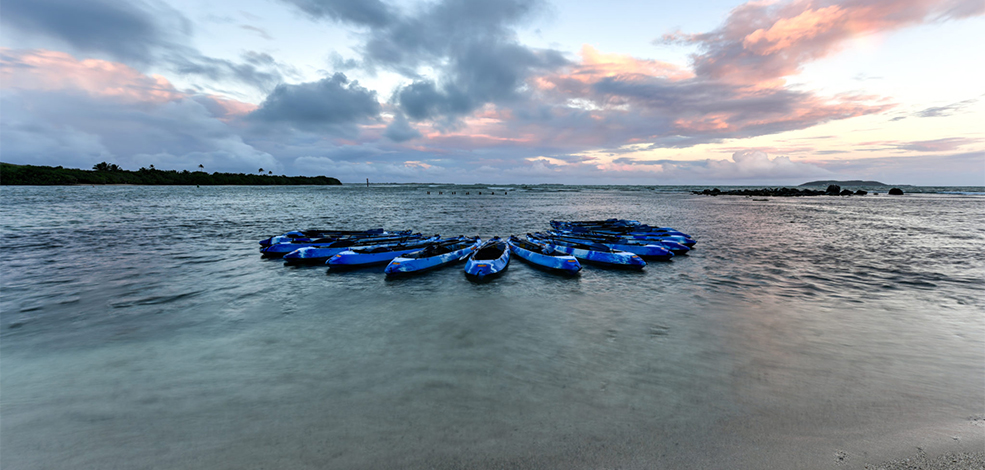
Kayaking in Culebra
With the most coral on the island, the reefs at Culebra’s Luis Peña Reserve treat kayakers and paddleboarders to stunning clear waters and schools of tropical fish and marine life. You don’t have to go scuba diving or snorkeling to experience the sheer beauty of Culebra, but it’s easy enough to pack your mask and dive in from your kayak.
You’re sure to enjoy the secluded cays and beaches of Culebra. Flamenco Beach and Carlos Rosario Beach have little to no waves so you can feel relaxed on the water whether you prefer kayaking or paddleboarding.
Fajardo
Fajardo is about an hour from San Juan on the east coast of Puerto Rico. As a coastal town, there are plenty of great beaches to launch your paddleboard or kayak and get some exercise.

Kayaking in Farjardo
For a full beach day, head to Seven Seas Beach with your gear (and the family!). This crescent-shaped beach boasts incredible views, gentle water, and the perfect environment for paddleboarding. Of course, if you’ll be in Fajardo, be sure to book a kayak tour at Laguna Grande, the bio bay!
La Parguera In Lajas
The southern coast of Puerto Rico is where you’ll find some of the territory’s best beaches and mangroves, along with countless kayaking tour operators. But we’re kind of burying the lead here—this is also where you’ll find the only bio bay in Puerto Rico you’re allowed to swim in. The blue effect will coat your body, but consider this fair warning: there may also be jellyfish in the water.
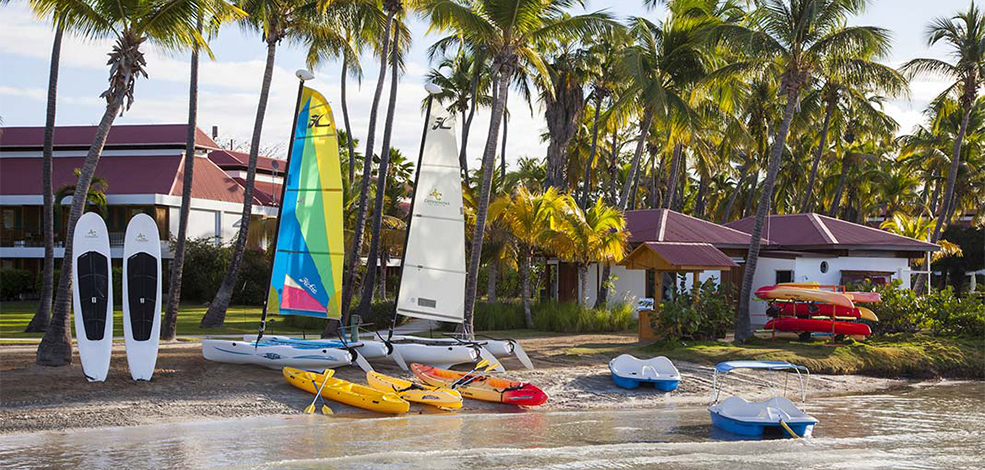
La Parguera In Lajas
La Parguera is located a two-hour drive southeast of San Juan in Lajas. Kayaking Parguera offers rentals, including hands-free (pedal-drive) kayaks, as well as tours of the mangrove tunnels and the bioluminescent bay.
You May Also Like
-

06 Jul 2022
Puerto Rico Videos -

07 May 2022
Best Family Friendly Activities -

30 Apr 2022
Best Hiking Trails in Puerto Rico -

29 Apr 2022
Food Trails and Culinary Adventures -

29 Apr 2022
Puerto Rican Cocktails & Drinks -

28 Apr 2022
Landmarks and Iconic Places -

27 Apr 2022
Puerto Rican Traditional Dishes -

26 Apr 2022
Events and Festivals in Puerto Rico -

25 Apr 2022
The Musical Sounds of the Island -

25 Apr 2022
Art Museums in Puerto Rico -

24 Apr 2022
Puerto Rico Natural Wonders -

17 Apr 2022
Best Beaches in Puerto Rico -

17 Apr 2022
The Best Spots for Watersports -

10 Feb 2022
Puerto Rico – Island of Enchantment -

01 May 2018
Where to Surf in Puerto Rico

